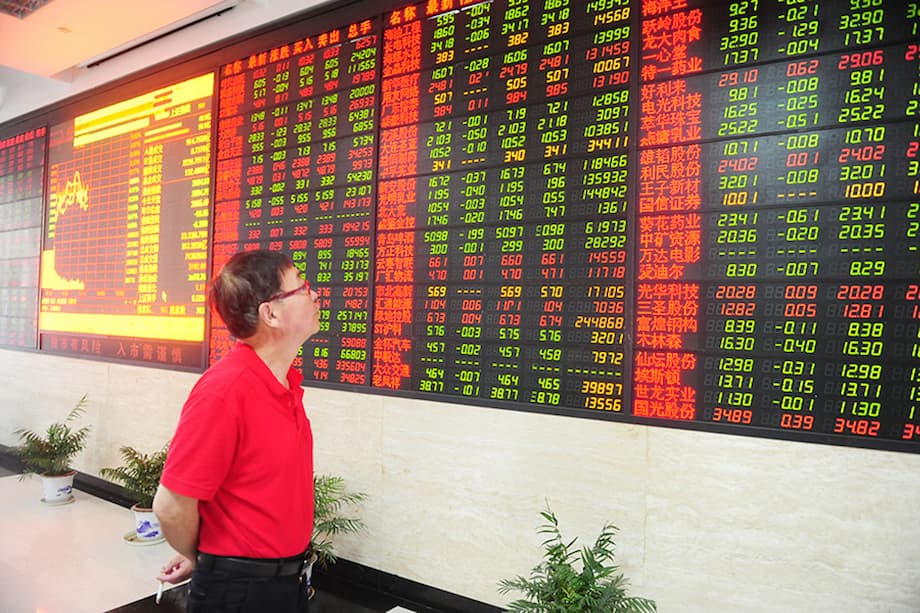Why this rally arrived now
China’s equity markets have roared back to life in 2025. The value of mainland and Hong Kong stocks has risen by more than 3 trillion dollars as big benchmarks climb and investor confidence improves. The CSI 300, a barometer of large mainland shares, is up around 16% this year. Technology gauges have vaulted to their strongest levels in a decade. The surge gathered pace even as several recent data points disappointed. That gap between market momentum and the economy has become the core debate. Bulls argue that equities are pricing a shift in China’s growth model, away from property and toward advanced manufacturing, green energy and artificial intelligence. Skeptics say the rally is racing ahead of fundamentals.
Two forces are most visible. Households are shifting cash away from low yielding bank deposits after years of elevated savings. Retail investors now account for close to 90% of daily turnover onshore. At the same time, Beijing’s policy support has reduced perceived downside risk. Measures since late 2024 include interest rate and reserve requirement cuts, easier share buybacks, and steps to strengthen market plumbing. The result is a feedback loop of rising prices, better sentiment and more inflows. Whether that cycle endures will depend on earnings and the durability of the policy push.
How far markets have run
Broad benchmarks show the scale of the advance. The MSCI China Index has gained more than 40% in 2025. The Shanghai Composite reached a ten year high. In Hong Kong, the Hang Seng Index has returned more than 30% this year and the Hang Seng Tech Index hit its best level in nearly four years. Within the mainland basket, the CSI 300 Information Technology Index climbed to its highest mark since 2015. These headline moves reflect a powerful bid into technology, consumer platforms and communications.
Gains are also concentrated in a handful of heavyweights. Alibaba has more than doubled this year. Semiconductor Manufacturing International Corporation has risen by about 180%. Tencent, Baidu and Xiaomi are ahead by roughly 60%. That concentration has increased the weight of the largest internet groups in major benchmarks. The three biggest names now account for a large share of MSCI China. Plenty of smaller companies also rallied, yet earnings have not uniformly caught up. In several sectors the jump in price to earnings ratios, rather than stronger profit forecasts, explains much of the move.
Why investors are pouring in
Three themes underpin the rally. Progress in artificial intelligence and a push for chip self sufficiency have changed sentiment toward Chinese technology. A rotation of household savings into equities has deepened liquidity. Policy support, including stronger market infrastructure and signals that authorities want a healthier stock market, provides a safety net that was missing during previous slumps.
AI and chips
The release of powerful domestic AI models at the start of the year energized the market and reset expectations about the pace of innovation. Major internet platforms boosted investment in data centers, cloud capacity and AI applications. Domestic chip names benefited from the drive to secure critical hardware and software. Earnings momentum in parts of the semiconductor complex has improved. One example is Cambricon, which reported first half profits of 2.88 billion yuan, up more than forty fold from a year earlier. Investors now view AI as a horizontal technology that can lift productivity in retail, logistics, entertainment and industrial automation. If adoption spreads across sectors, that could translate into stronger cash flows and more resilient margins over time.
Retail money and low deposit rates
Data from the central bank point to a steady rotation out of term deposits. Deposits at non bank financial institutions increased by 2.15 trillion yuan in July and 1.17 trillion yuan in August. M1 money, a gauge of cash that can be deployed quickly, rose 6% year on year in August, the fastest pace since early 2023. Household savings total more than 160 trillion yuan, yet only a small share sits in equities. Falling deposit rates and lingering caution toward property have made stocks more attractive on a relative basis. That pool of savings serves as a potential engine for further flows if returns in the market remain competitive.
Beijing has also moved to curb destructive price wars in crowded industries. Regulators have talked about reining in extreme discounting in areas with excess capacity. If companies regain some pricing power, that could support profits in sectors such as autos, electronics and renewables. Investors see these steps as part of a broader effort to strengthen corporate balance sheets and lift returns on equity.
A mixed economic picture
Macro data still point to a slow patch. Industrial output grew 5.2% in August, down from 5.7% the prior month. Retail sales increased 3.4% year on year, below expectations and slower than July. Exports rose 4.4%. Property investment fell 12.9% in the year through August, a deep contraction that underscores the long adjustment in real estate. Producer prices have been negative for nearly three years and consumer price inflation has hovered around zero for more than two years. That combination of overcapacity in some supply chains and weak domestic demand has weighed on margins.
Some market strategists argue that stocks are front running an eventual improvement rather than reflecting current conditions. Chaoping Zhu, a global market strategist at J.P. Morgan Asset Management, framed it this way.
So far, we have not seen signs of a turnaround in macro fundamentals, although the current momentum might be supported by expectations for structural improvements in the economy.
There are early signs of stabilization in selected areas such as semiconductors, AI and renewables. A campaign to limit extreme price cutting could also help restore margins if it is enforced in a measured way. Yet the property slump remains a drag on household wealth and local government finances. That is why many investors describe the upswing as a bet on future reform and productivity gains rather than a response to an already strong recovery.
Boom or bubble
Views diverge on sustainability. Some investors see strong policy support and deep cash reserves on the sidelines as reasons the rally can extend. Others worry that valuations have run ahead of earnings. Raymond Cheng, regional chief investment officer for North Asia at Standard Chartered, highlighted the tension between market prices and the data.
China’s ongoing equity rally appears disconnected with the economic fundamentals.
Hao Hong, managing partner and chief investment officer at Lotus Asset Management, thinks the broad market is not overheating, while warning that some segments look frothy.
There are few signs of overheating in the overall market, but pockets of the market are a little too hot. This is not yet a bubble, but it is going that way.
These perspectives capture the core trade off. Momentum is strong, liquidity is ample and policy is supportive. At the same time, heavy optimism in certain niches like contract research firms and select AI names leaves them vulnerable if earnings fall short or if positioning becomes crowded.
Winners and hotspots
Technology, consumer platforms and communications sit at the center of the rebound. Investors rewarded companies with credible AI roadmaps, large user bases and strong cash generation. The rebound in smartphone supply chains and signs of stabilization in electric vehicles supported related names. Internet giants integrated domestic AI models into search, e commerce, content and advertising, while boosting capital spending on cloud and data infrastructure to support those initiatives. The lifting effect on indexes grew as these large companies rallied together.
Semiconductors and hardware linked to computing power have also gained. The push for domestic chip capabilities, combined with steady demand for servers and networking equipment, has lifted earnings expectations for select suppliers. Still, the rally has not been uniform. Contract research organizations and some AI adjacent firms have seen valuations stretch beyond historical bands. That pattern suggests investors are paying up for growth stories tied to strategic priorities, yet selectivity is critical when price to earnings multiples jump without a corresponding shift in profit outlooks. The primary equity market is stirring too, with more technology listings moving to Shanghai and Hong Kong as founders seek to raise capital closer to home.
Foreign money returns
Global investors are stepping back into China after a long period of caution. Hedge funds have been active in onshore A shares. Cross border flows have picked up across several asset classes, a pattern that has been rare in recent years. The fear of missing out on a broad China rebound now competes with concerns about policy risk and geopolitical tension. That shift matters because foreign participation can deepen liquidity and improve price discovery.
Valuations help explain some of the appeal. Chinese equities trade above their ten year average, but still at a discount to the S&P 500. For many global managers, the combination of discounted multiples, rising earnings potential in AI and strong policy focus on capital markets has tipped the balance toward cautious re entry. Steps by authorities to widen access to derivatives, encourage buybacks and improve market supervision have also reassured institutions that the trading environment is improving. These are incremental changes, yet they can support a gradual increase in long horizon capital.
Risks that could upset the rally
The market’s biggest near term risk is the gap between prices and profits. Earnings estimates for major China indexes have drifted lower for 2025 and 2026 even as share prices rose. That means a larger slice of the move reflects valuation expansion, which can reverse quickly if growth stalls. Another risk is leverage. Retail participation brings energy, yet it can also amplify swings if margin levels rise and investors react to headlines. Regulatory surprises remain a factor. Past crackdowns on tech, education and property still weigh on confidence. If rules change abruptly, investors may demand a higher risk premium.
External pressures could also bite. Export controls on advanced chips, tighter investment screening and a slower global economy could limit the upside for manufacturers. The property downturn is not resolved, which keeps pressure on household confidence and bank balance sheets. Local governments face strained finances, with unpaid obligations estimated at more than 1 trillion dollars. A strong stock market may help through higher dividend income and the option to monetize equity holdings, yet it cannot fully offset the drag if property continues to shrink.
What investors should watch
Markets are forward looking. That is why this rally has thrived despite a soft data run. For it to graduate from sentiment to substance, several signposts matter. Earnings from major internet and hardware companies need to follow through on the AI narrative. Profitability in autos, solar and consumer electronics should benefit if price discipline holds. Stabilization in property sales, even at lower levels, would reduce a key drag on household wealth. Clear guidance on how regulators will address excess capacity can lift margins without damaging employment. Steady foreign inflows and more domestic fund allocation to equities would also support liquidity. Finally, signs of stronger household consumption would validate the bet that productivity gains can feed into broader growth.
Key Points
- China’s equity markets added more than 3 trillion dollars in value this year as the CSI 300 rose about 16% and tech benchmarks hit decade highs.
- AI progress, the rotation of household savings from deposits to equities and policy support have been the main drivers of the rally.
- Macro indicators remain soft, with industrial output up 5.2% in August, retail sales up 3.4% and property investment down 12.9% year to date through August.
- Strategists are split. Some see disconnection from fundamentals, while others see pockets of froth rather than a broad bubble.
- Gains are concentrated in large tech names. Alibaba and SMIC led advances, while some contract research and AI adjacent firms look stretched.
- Foreign investors are returning, attracted by discounted valuations versus the S&P 500 and improving market infrastructure.
- Key risks include earnings that lag prices, leverage among retail traders, regulatory shifts, export controls and a long property downturn.
- Watch for earnings follow through on AI, progress on price discipline in crowded industries, stabilization in property and signs of stronger consumption.












